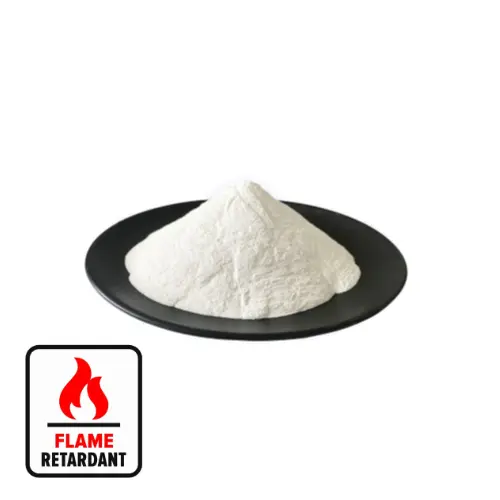The excellent performance of magnesium hydroxide flame retardant comes from the physical and chemical properties determined by the morphology, size and dispersion of its crystals. Due to the special structure, mechanical properties and dispersion, the magnesium hydroxide crystals with flaky structure have both filling and halogen flame retardant functions in thermoplastic polymers and fiber materials, and can increase the combustion starting temperature of polymer materials and increase thermal stability. Therefore, magnesium hydroxide with hexagonal flaky morphology will become the theme of magnesium hydroxide flame retardant materials, and the preparation of flaky magnesium hydroxide is one of the most promising directions in the preparation of high-quality flame retardants.

1. Introduction
Magnesium hydroxide, chemical formula Mg(OH)2, formula weight 58.32. White amorphous powder. Also known as caustic magnesia, lightly burned magnesia, etc. The suspension of magnesium hydroxide in water is called magnesium hydroxide emulsion, abbreviated as magnesium milk, and its English name is Magnesium hydroxide. Magnesium hydroxide is a colorless hexagonal crystal or white powder, which is difficult to dissolve in water and alcohol, soluble in dilute acid and ammonium salt solution, and its aqueous solution is weakly alkaline. Its solubility in water is very small, but the part soluble in water is completely ionized. The concentration of saturated aqueous solution is 1.9 mg/L (18℃). It loses water when heated to 350℃ to form magnesium oxide. Magnesium hydroxide is a natural mineral brucite. It can be used to make sugar and magnesium oxide, etc. Because magnesium hydroxide is relatively abundant in nature and its chemical properties are similar to aluminum, users began to use magnesium hydroxide to replace aluminum chloride for fragrance products. It is used as an analytical reagent and also in the pharmaceutical industry.
2. Advantages
Magnesium hydroxide is an inorganic flame retardant filler for polymer-based composite materials with good application prospects. Like aluminum hydroxide, magnesium hydroxide flame retardant relies on chemical decomposition to absorb heat and release water when heated to play a flame retardant role. Therefore, it is non-toxic, low-smoke, and the chemical properties of the magnesium oxide generated after decomposition are stable and non-toxic. Produce secondary pollution and other advantages.
3. Disadvantages
However, compared with halogen-containing organic flame retardants, to achieve considerable flame retardant effects, the filling amount generally needs to reach more than 50%. Since magnesium hydroxide is an inorganic substance, its surface has poor compatibility with the polymer base material. With such a high filling amount, if it is not surface modified, it will lead to composite materials after being filled into the polymer material. The mechanical properties decrease.
4. Solution
Therefore, it must be surface modified to improve its compatibility with the polymer base material so that the mechanical properties of the filling material do not decrease, and even some of the mechanical properties of the material are improved.
It is worth mentioning that my country formulated the industry standard for industrial powdered magnesium hydroxide (HG/T3607-2000) in December 2000 and began to implement it on December 1 of the same year. This is what I’ve seen so far
The only professional standard, it was later replaced by HG/T3607-2007. The production scale of magnesium hydroxide of different specifications and varieties abroad is very large, and its application in different fields has a history of nearly 20 years, but there has never been any official standard promulgated.
Magnesium hydroxide not only does not produce any harmful substances during the entire flame retardant process, but its decomposition products are flame retardant and can also absorb a large amount of harmful gases and smoke generated by the burning of rubber, plastics and other polymers. Active magnesium oxide continuously absorbs The melted residue of incomplete combustion can quickly stop combustion while eliminating smoke and preventing droplets. It is an emerging environmentally friendly inorganic flame retardant.
The main varieties of inorganic flame retardants include aluminum hydroxide, magnesium hydroxide, red phosphorus, antimony oxide, tin oxide, molybdenum oxide, ammonium molybdate, zinc borate, etc. Among them, aluminum hydroxide and magnesium hydroxide absorb large amounts of heat due to their decomposition. , and generate H2O, which can isolate the air. After decomposition, the oxide is a high-temperature resistant substance. Therefore, the two flame retardants can not only play a flame retardant role, but also can play a filling role. They are non-corrosive. It has the characteristics of halogen and harmful gases, non-volatile, long-lasting effect, non-toxic, smoke-free and non-drip.
At present, a large amount of aluminum hydroxide is used in China, but as the polymer processing temperature increases, aluminum hydroxide is easy to decompose and reduces the flame retardant effect. Magnesium hydroxide has the following advantages over aluminum hydroxide:
1. The thermal decomposition temperature of magnesium hydroxide reaches 340°C, which is 100°C higher than that of aluminum hydroxide. It is conducive to increasing the plastic processing temperature, speeding up the extrusion speed, improving the plasticizing effect, shortening the molding time, and the surface gloss of the product is high. Will produce surface defects, while ensuring super peeling strength;
2. Uniform particle size distribution, good compatibility with the base material, and little impact on the mechanical properties of the product;
3. Magnesium oxide generated after magnesium hydroxide is burned and dehydrated is a high-strength, high-heat-resistant material that can be used as a protective wall to isolate fire sources and toxic and harmful gases. Magnesium hydroxide has strong neutralizing ability with acids and can Quickly neutralize acidic gases SO2, NOx, CO2, etc. produced during the plastic combustion process;
4. Magnesium hydroxide has high decomposition ability, high flame retardant efficiency, strong smoke suppression ability, low hardness, and low friction on equipment, which helps to extend the life of equipment;
5. Low price and large filling capacity can greatly reduce the cost of the product.

